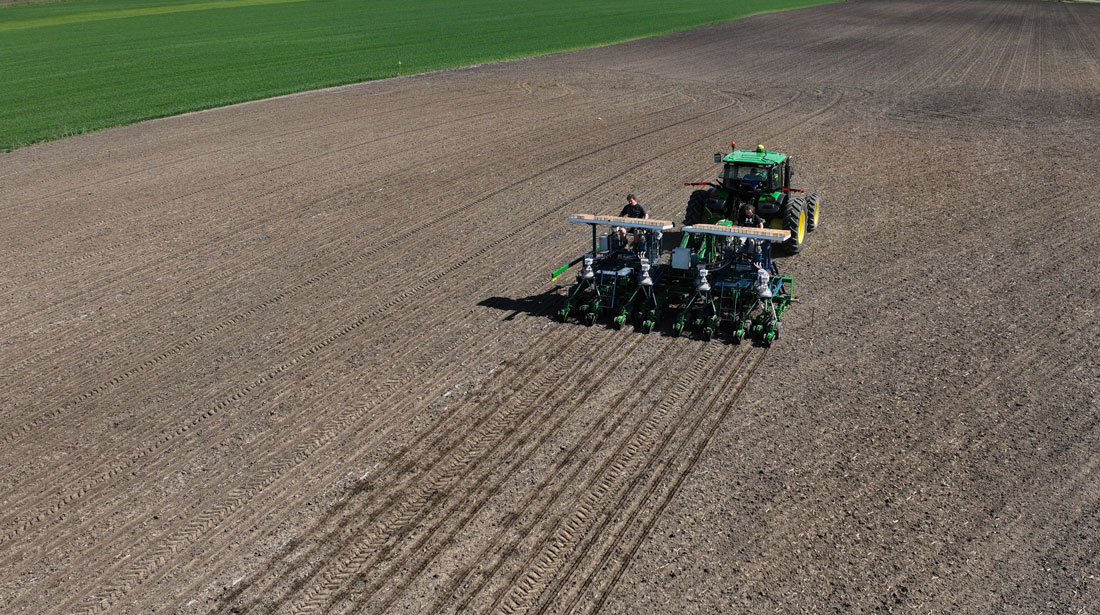Rain continues to be a barrier for farmers seeking to finish planting before crop insurance deadlines. According to the USDA’s National Agricultural Statistics Service’s May 20 Crop Progress Report, some corn and soybean planting occurred in the past week but is still behind schedule compared to last year. Specifically, 70% of corn is in the ground versus 76% at this time last year and 71% of the 2019–2023 average. Of corn planted, 40% has emerged. Soybean planting is 52% complete compared to 61% at this time last year but is ahead of the five-year average of 49%. Around 26% of soybeans have emerged.

Regional updates
Stine’s agronomy team is busy scouting fields and managing plot planting progress. From the East Coast to the South to the Midwest, here’s what our agronomists are reporting from their regions.

Jacob Foote, field agronomist, eastern U.S.
As of this week, we have all our Michigan Product Development Plots (PDPs) planted. We have been delayed a little due to frequent rain in both Indiana and Ohio, but these next few weeks look promising. We hope to make more progress this week. A concern in our region is the potential for phytophthora root rot and possible slug outbreaks. With the wet and warmer conditions, phytophthora can really impact seedling emergence. We are seeing slug issues in our more southern locations, especially in fields with a thick layer or residue from last year’s harvest.

Mark Johnson, technical agronomist, Mid-South
My region includes Missouri, Kansas, Arkansas, Louisiana, west Tennessee and west Kentucky. Planting has been all over the board, but the one common denominator is rain. We started planting corn PDPs the first of April, and I hope to finish with the last one in east-central Missouri by the end of this week, assuming it does not rain again. In total, we have seven out of nine corn PDPs in the ground.
Soybeans are another story: We have one planted in western Kentucky, and if I get lucky, one in Kansas later this week. Rain keeps holding up planting with the plots.
Planting progress across my area is very scattered as rain patterns are playing a big part in my north-to-south coverage

Faith Hedrick, field agronomist, Illinois and Wisconsin
Planting in our Illinois and Wisconsin PDPs is finally moving along. We’re over halfway done and, depending on the weather, will hopefully wrap things up this week or next. Getting in the field has been a struggle this year for my area as weather conditions have not been ideal. Rain has delayed planting in much of the Midwest this season, and cold, wet conditions have caused issues for growers who got in the field early. Needless to say, it’s been a constant battle week in and week out. However, Mother Nature seems to be easing up on us as forecasts are looking up, and we’re making progress now. Some of the PDPs planted at the beginning of May have emerged, and so far, stand counts look good with some strong emergence. Overall, the clouds are clearing, and we're finally getting into the swing of things this season.

Daniel Greblunas, field agronomist, Nebraska, Kansas and Missouri
As of today, we have six corn plots planted in Nebraska, Kansas and northwest Missouri, and one remaining that should be planted later this week in Kansas. On the soybean side, we have two planted in Nebraska with two more being planted later this week in Kansas. In my area, there are a lot of people who are finished with corn and moving over to soybeans if they are not already done. All the corn that was planted for my plots has emerged and is off to a great start. People are still fighting the rain trying to get in and finish planting. Most of the corn planted in my area is off to a strong start. We will know more about how soybeans are responding as they begin to emerge.
Stay tuned next week for more regional crop progress updates. Remember, our sales reps and agronomists are available year-round to answer your agronomic or product questions.
Related Articles
-

Stine® to offer Syngenta’s Victrato® soybean seed treatment in 2026
December 2025 in Agronomy
-

Use Stine’s XP® seed treatments to prevent early injury to your crops
December 2025 in Agronomy
-

Understanding Stine’s enhanced oil profile soybeans
December 2025 in Agronomy
-

Soil sampling sets the stage for spring
November 2025 in Agronomy



